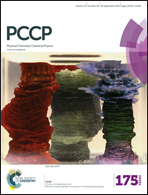The effect of water on discharge product growth and chemistry in Li–O2 batteries†
Abstract
Understanding what controls Li–O2 battery discharge product chemistry and morphology is key to enabling its practical deployment as a low-cost, high-specific-energy energy conversion technology. Several studies have recently shown that the addition of substantial quantities (hundreds to thousands ppm) of water and weak acids to dimethoxyethane (DME)-based electrolytes can significantly increase Li–O2 battery discharge capacity, without substantially changing the discharge product chemistry, which remains Li2O2. The exact mechanisms behind these device-level improvements, however, are not yet understood. In this study, we show that the presence of water in a DME-based electrolyte decreases the rate of Li2O2 nucleation on the electrode surface during Li–O2 battery discharge, using potentiostatic electrochemical measurements, and direct, ex situ observations of Li2O2 particles. We also show that adding water to an acetonitrile (MeCN)-based electrolyte results in LiOH upon discharge, as opposed to only Li2O2. Using first principles calculations, we propose that this change in discharge product chemistry is attributable to increased proton availability, as shown by a lower pKa for water in MeCN than in DME. This study combines kinetic and morphological analyses with first principles calculations, and elucidates relationships among electrolyte composition, discharge product chemistry and growth mechanisms for the rational design of efficient metal–air batteries.


 Please wait while we load your content...
Please wait while we load your content...